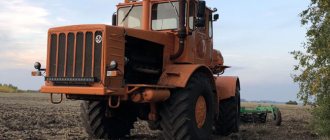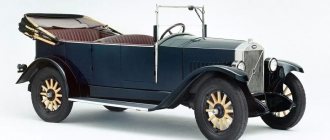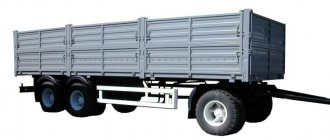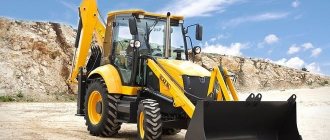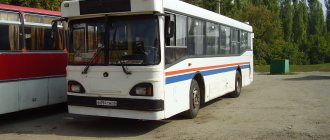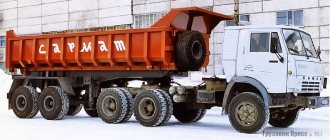| Successor | Kutaisi Auto Mechanical Plant (KAMP) |
| Based | 1951 |
| Headquarters | Kutaisi , Georgia (formerly Soviet Union) |
| Goods | trucks |
| Parent | Georgian Industrial Group |
| Web site | Kutaisi Auto Mechanical Plant (KAMP) |
To Kutaisi Automechanical Plant (KAMP)
(Georgian: ქუთაისის ავტომექანიკური ქარხანა,
kutaisis avtomekanikuri karkhana
), formerly
Kutaisi Automobile Plant - KAZ
( Georgian: ქუთაისის საავტომობილო ქარხანა,
kutaisis saavtomobilio k'arkhana
); named in the Soviet Union after Sergo Ordzhonikidze), this truck plant is located in Kutaisi, Georgia.
Goods
- KAZ-150 (Photo)
- KAZ-120T (Photo)
- KAZ-585 (Photo)
- KAZ-600 (Photo)
- KAZ-601 ()
- KAZ-605 Colchis (
) KAZ-606 Colchis experimental (g.) - KAZ-606/606A (
) - KAZ-608 Colchis ()
- KAZ-608V Colchis ()
Alien car plant
Kutaisi is considered the largest city in western Georgia; you can get to it from Tbilisi by bus or train. There are also air connections with the cities of Ukraine, Armenia and Turkey. A depressive mood reigns not only in the city center, but also on the outskirts, where the main character, the KAZ automobile plant, is located. The huge industrial-dormitory area was designed for one factory. People worked here with whole families, living with common tasks, problems and goals of the auto giant. In total, at the end of the 80s of the twentieth century, about 18 thousand people worked at the enterprise, which is impressive even by the standards of Soviet urban planning.
The workshops begin long before the central entrance. Once upon a time, trolleybus route No. 8 connected the city center with KAZ; the last 4 stops of the trolleybus route ran along the automobile plant. Today there are no trolleybuses, and huge buildings rise along the street. The windows of the first floors gape empty, and there are thickets of wild bushes and trees around. This is the picture from the outside.
At the main entrance, two blue Imechi-35 tractors plunged into a puddle from the ramps. The first thought: the plant chose a niche for the development of agriculture and KAZ began producing special equipment for cultivating fields and harvesting crops.
Technical characteristics of the KAZ-608 in numbers
- Overall dimensions – 5155 x 2360 x 2440 mm (in the cabin).
- Wheelbase (distance between front and rear axles) – 2900 mm.
- The distance between the wheels on one axle is 1800 mm.
- The curb weight of the truck tractor is 4000 kg.
- Ground clearance at the front is 340 mm, at the rear with a load – 275 mm.
- The angle of entry under load on the saddle is 30 degrees.
- The braking distance in the hitch when driving at a speed of 40 km/h is 20 meters.
- The minimum turning radius is 7 meters.
- The volume of fuel tanks is 2 x 125 liters. The volume of oil for engine lubrication is 9 liters. The volume of the engine cooling system is 26 liters.
Active protection complex - "Arena"
In 1997, a more advanced active protection complex, Arena, was first demonstrated to the general public. The T-80UM-1 tank, equipped with this KAZ, with a characteristic birdhouse superstructure of the radar antenna unit on the turret, attracted the close attention of military specialists.
Scheme of combat operation of KAZ "Arena": 1. Protective bunkers. 2. Radar. 3. Protective fragments. 4. Anti-tank missile. 5. Tracking phase
In terms of its combat characteristics, Arena was significantly superior to its predecessors. The viewing sectors expanded, reaching 270 degrees in azimuth, and the performance increased—the interval from target detection to its destruction was no more than 0.07 s. Although the maximum speed of ATGMs and grenades that the complex was capable of intercepting did not change - just like that of the Drozd, it was about 700 m/s (this was guaranteed to make it possible to destroy an RPG shot, conventional missiles from an ATGM and supersonic missiles from ATGMs of the “Chrysanthemum” or “Sturm” type), but the amount of protective ammunition has increased significantly. They were placed around the perimeter of the tank turret in special installation shafts (the tank could carry up to 26 such ammunition). "Arena" did not respond to targets located at a distance of more than 50 m from the tank, and to small targets (bullets, fragments, clods of dirt or snow).
Today, ATGMs are tough and steel armor more than 1000 mm thick, which is impossible to attach to a tank, since as a result it will lose all its mobility. The use of dynamic protection elements on armored vehicles does not help the situation either.
Tank T-80U with the Arena complex. A characteristic radar unit is installed on the roof of the turret, and defensive ammunition launchers are located on the forehead and cheekbones. Scheme of the “protective umbrella” provided by KAZ “Arena”
However, the military also had complaints - the antenna unit of the Arena radar, installed on a special mast, rose greatly above the roof of the tower, did not have serious protection and could become “easy prey” for the enemy. Moreover, after the radar is destroyed or disabled, the entire complex weighing almost 1.3 tons becomes a useless load and even an obstacle to the tank’s maneuver on the battlefield.
In 2006, the base cost of the complex was $300 thousand. They tried to install it on all types of Russian tanks and even on the BMP3. Probably, on the relatively weakly armored BMP-3 it could prove itself most effectively: the landing party inside the combat vehicle would feel more protected from enemy fire. However, things never went further than testing.
Transmission; suspension and chassis; brakes; steering
The ZIL-130YA5 engine worked in conjunction with a five-speed manual gearbox; clutch - dry type, single disc.
The stamped frame of the car consisted of channel-type spars, which were connected to each other by cross members. The front suspension is leaf spring, using rear leaf springs from the GAZ-66 SUV. Telescopic shock absorbers with double action and a beam with an I-section. Rear suspension - leaf spring, from ZIL-130, with the addition of additional springs.
Tires are pneumatic, with tubes and a standard pressure of 4.3 atmospheres. Brakes - pneumatically driven by a pedal, classic shoe type on all wheels. The trailers are equipped with a single-line braking system. Worm-type steering with a three-ridge roller, equipped with a built-in hydraulic booster. The power steering pump is rotated by a belt from the crankshaft.
Interrogation in dungeons
We can put an end to this, but today relations between Russia and Georgia are going through the worst times. This was reflected in my further stay in Kutaisi. A few hours later I was already on a tour of the dungeons of the special services, where I was interrogated with passion about the purpose of the visit and the photographs taken. Most of what I managed to capture with my camera was mercilessly deleted, and only a little managed to survive in long and heated disputes with Georgian counterintelligence.
Kutaisi Automobile Plant (KAZ)
The Kutaisi Automobile Plant named after Sergo Ordzhonikidze began to be built in 1945. At the beginning of its journey, KAZ was not an automobile, but a car assembly plant. KAZ is the largest enterprise in Georgia that came into operation in the fifth five-year plan.
In 1950, the plant mastered the production of engines and gearboxes. On August 18, 1951, the first car in Georgia, the KAZ-150, rolled off the assembly line. From the components supplied from the ZIS, the production of onboard vehicles was established, and later the specialization of the first Georgian automobile plant was changed, repurposing KAZ to produce dump trucks and truck tractors, of which much less was produced in Moscow.
Its own design bureau began operating in the mid-1950s. In 1952, specialists developed a 3.5-ton KAZ-585B dump truck and a KAZ-120T truck tractor for towing single-axle dump semi-trailers - KAZ-716 cotton trucks, intended for transporting bulk cotton. Both cars, with minor differences, repeated the ZIS prototypes.
In 1956, the plant began producing the KAZ-600 dump truck with three-way unloading of its own design. In parallel with the dump truck, the production of the KAZ-601 cement tanker was also mastered.
The KAZ-606 “Kolkhida” went into production in the second half of 1961 and became the first serial truck tractor in the USSR with a cab over the engine. The development of a car with a cab over the engine is a great achievement by the designers of the Kutaisi Automobile Plant.
Since 1962, an updated model of the KAZ-606A truck tractor began to roll off the plant’s assembly line. The production of road trains was carried out using the in-line method; the assembly of cars and their main components was carried out on conveyors. They also produced automobile engines, spare parts for automobiles, as well as cultural, household and household items: garden carts, latches, latches, etc.
In 1963, prototypes of the modernized KAZ-608 truck tractor were manufactured. In 1973, Kutaisi cars received a new spacious cabin and a digital index KAZ-608V.
Since January 1984, after passing interdepartmental tests, the KAZ-4540 went into production.
After the collapse of the USSR, car production decreased greatly. In the 1990s, KAZ tried, using the KAZ-4540 as a base vehicle, to create a family of trucks (flatbeds, tanks, dump trucks, vans and garbage trucks), including 4x4 and 4x2 with a KAZ cab, and also developed the “Georgian Multicar” - a small transporter KAZ-NAMI-0342, designed for small farms, but the lack of investors left this car a dream. In 1991, the Kutaisi Automobile Plant practically ceased its activities.
On January 14, 2002, at the Kutaisi automobile plant, which had previously been idle, a presentation of the project for SKD assembly (the so-called “screwdriver”) of Indian SUVs from the Mahindra & Mahindra company with a capacity of 1000-1200 cars per year took place. It was planned that the jeep would be supplied not only to the Georgian market, but also to some Transcaucasian countries - Armenia and Azerbaijan. It was reported that the contract for a total amount of $26 million was signed at the end of 2001. The further fate of the project is little known.
At the end of 2009, a joint venture with the German company MAN to assemble trucks was announced, but no vehicles have been produced to date.
Historical recyclables
Some readers may think that we were just driving around the factory, but I hasten to make it clear: we were looking for a museum! That's exactly what we were looking for!
Yes, yes, there was and still is a museum of the history of the enterprise at the plant. What’s even more incredible is that this museum preserves two full-scale trucks that KAZ produced. My guide in the museum was the last director of the enterprise, D. A. Devidze.
A small building, similar to a mini-hangar, became the cherished goal. Behind its doors, stands with photographs of all the directors of KAZ, photographic documents of the construction of workshops, and models of trucks from the times of the USSR survived.
Between the supporting columns there is a KAZ-585V dump truck and a KAZ-608V tractor, which have not yet been touched by the wave of repressions, color revolutions and crises. Photo albums and technical documentation gather dust on tables and in piles like waste paper. Bookworms multiply, live and breed in the bindings of these valuable books. There has been no heating in this echoing room for almost 15 years! For more than two hours I curiously leafed through the archives of the enterprise. It turned out that until 1998 KAZ even produced its own factory small-circulation “Matsne” (cargo - car).
The saddest thing is that the fate of this museum is already predetermined - the documents are waiting for a trash heap, and all diesel engines, full-scale samples of units, hardware and models of equipment will be sent to the open-hearth furnaces of the Rustavi Metallurgical Plant, which is also engaged in the remelting of historical monuments of the Georgian SSR.
At the end of the meeting, Didim Archilovich hoped that the Kutaisi mayor’s office would still pay attention to the plant and preserve the collection. Let at least the descendants be proud that “Kolkhida” trucks were made in Kutaisi for all the republics of the Soviet Union.
